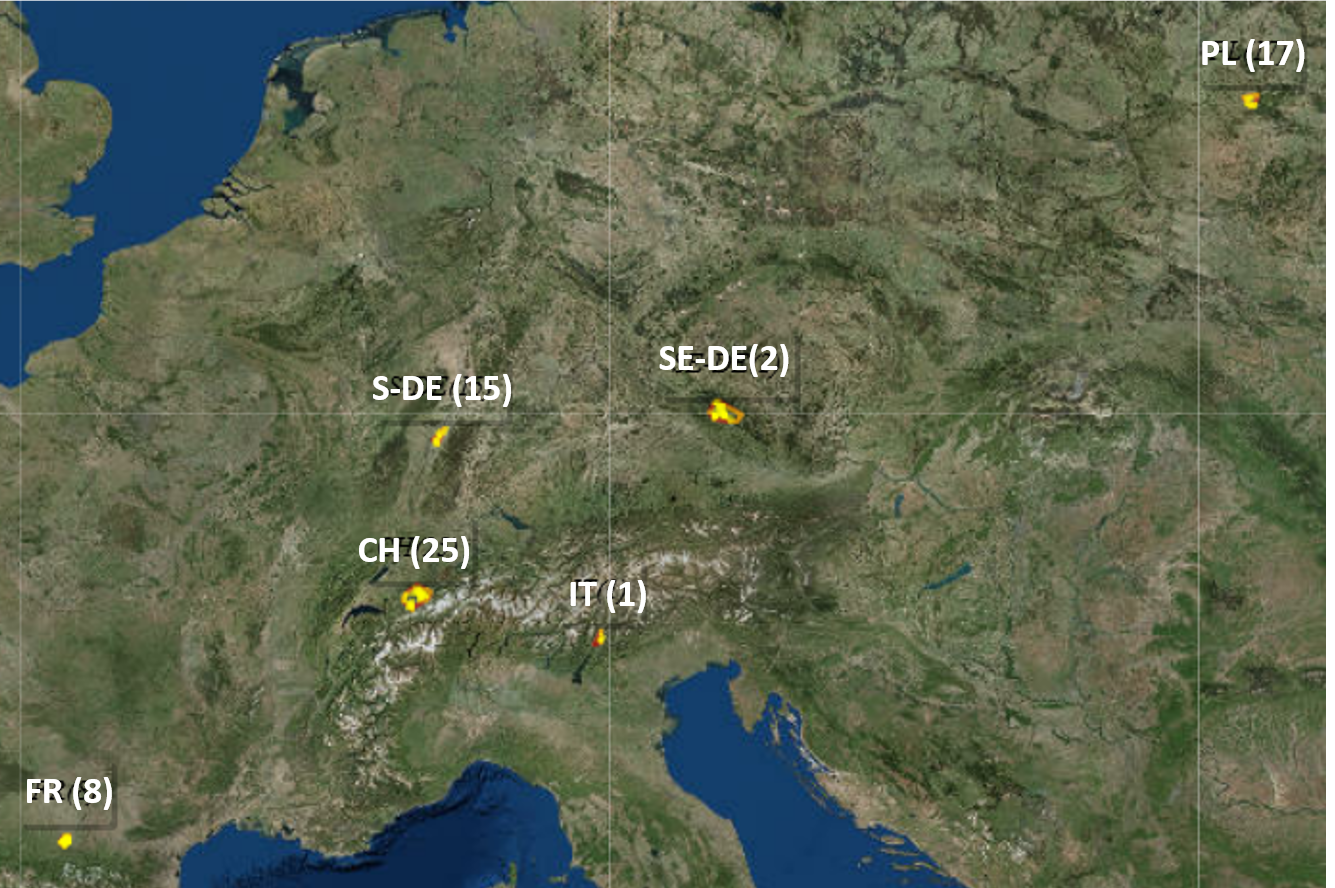This project does focus on methods to quantify home range and activity for roe deer, based on animal biotelemetry data that was collected within the Eurodeer consortium. In the sign-up period (15 August - 15 September 2019), 25 research teams joined the project. It is expected to be finalized in 2020.
Research question and data
We will analyse the data set to answer the following question:
How is roe deer home range size related to level of activity both within and between individuals, when controlling for resource availability and landscape structure?
For this question we will use GPS movement tracks and accelerometer data for roe deer. The set comprises 141 individuals from 6 populations (CH, Swiss Alps; IT, Italian Alps; FR, southwest France; SE-DE, southeastern Germany; S-DE south Germany; PL, northeastern Poland). THe location of each population is shown on the map below (each population is identified by the abbreviation as well as a numerical code (code used in the Eurodeer data base). Each of the included individuals was monitored for at least 305 days (~10 months; animals were monitored for 496 days on average).

A more detailed description of the data is available here.
Protocol
The project participants use a general protocol as main guidance. In this protocol the definitions of the most important concepts are provided as well as the outputs that should be reported and shared at the various project stages.
Even though the protocol is provided at the start of the project and aimed to be complete, we may gain insight during the initial analysis phase and make some adjustments to e.g. adjust the requested outputs or provide clarification on the interpretation of some variables.
The protocol is provided here.
We work according to a rather strict time plan, which starts with an analysis phase. The details of the time plan are provided here.
Background
A lot is known about roe deer ecology, and a fair amount of the studies to roe deer ecology and behaviour have been conducted using biotelemetry data (notably using gps and accelerometer or activty sensors). Throughout this literature home range sizes, activity patterns and resource availability have been studied in relation to various ecological and behavrioural. We provide a few references to important publications on these topics, so that project participants may quickly find relevant information about the study system.
In relation to the question we investigate in this project, the definitive article to study first is Morrelet et al. (2013). It investigates the relation between home range size and environmental factors across Europe, thereby using partially the same study sites that are included in our data set.
To learn more about activity patterns, the papers by Cederlund (1989), Kämmerle et al. (2017), Krop-Benesch et al. (2013) and Pagon et al. (2013) can be consulted.
Literature
Cederlund, G., 1989. Activity patterns in moose and roe deer in a north boreal forest. Ecography, 12(1), pp.39-45. https://doi.org/10.1111/j.1600-0587.1989.tb00820.x
Kämmerle, J.L., Brieger, F., Kröschel, M., Hagen, R., Storch, I. and Suchant, R., 2017. Temporal patterns in road crossing behaviour in roe deer (Capreolus capreolus) at sites with wildlife warning reflectors. PloS one, 12(9), p.e0184761. https://doi.org/10.1371/journal.pone.0184761
Krop-Benesch, A., Berger, A., Hofer, H. and Heurich, M., 2013. Long-term measurement of roe deer (Capreolus capreolus)(Mammalia: Cervidae) activity using two-axis accelerometers in GPS-collars. Italian Journal of Zoology, 80(1), pp.69-81. https://doi.org/10.1080/11250003.2012.725777
Morellet, N., Bonenfant, C., Börger, L., Ossi, F., Cagnacci, F., Heurich, M., Kjellander, P., Linnell, J.D., Nicoloso, S., Sustr, P. and Urbano, F., 2013. Seasonality, weather and climate affect home range size in roe deer across a wide latitudinal gradient within Europe. Journal of Animal Ecology, 82(6), pp.1326-1339. https://doi.org/10.1111/1365-2656.12105
Pagon, N., Grignolio, S., Pipia, A., Bongi, P., Bertolucci, C. and Apollonio, M., 2013. Seasonal variation of activity patterns in roe deer in a temperate forested area. Chronobiology international, 30(6), pp.772-785. https://doi.org/10.3109/07420528.2013.765887